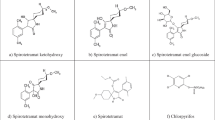Abstract
The present study was carried out to observe the dissipation pattern of triazophos on capsicum and risk assessment of its residues on human beings and to suggest a waiting period for the safety of consumers. Following two applications of triazophos (Truzo 40 EC) at 500 and 1000 g a.i. ha−1, the average initial deposits were found to be 3.61 and 6.26 mg kg−1, respectively. These residues dissipated below the limit of quantification (LOQ) of 0.05 mg kg−1 in 10 and 15 days at the recommended and double the recommended dosages, respectively. The calculated values of half-life were 2.31 and 2.14 days at recommended and double the recommended dosages, respectively. Theoretical maximum residue contribution (TMRC) values were found to be 28.8 and 41.6 μg person−1 day−1 at 500 and 1000 g a.i. ha−1, respectively, and found to be below the maximum permissible intake on capsicum fruit on the 7th day. Therefore, a waiting period of 7 days is suggested for consumption of capsicum sprayed with triazophos at the recommended dosages.




Similar content being viewed by others
References
Anonymous. (2002). Opinion of the scientific committee on food on capsaicin. European Commission Health & Consumer Protection Directorate-General. http://ec.europa.eu/food/fs/sc/scf/out120_en.pdf.
Gill, M. S., & Dhillon, T. S. (2013). Package of practices for cultivation of vegetables. Ludhiana: Punjab Agricultural University.
Gunther, F. A., & Blinn, R. C. (1955). Analysis of insecticides and acaricides (p. 696). New York: Interscience Publishers Inc.
Hoskins, W. M. (1961). Mathematical treatments of loss of pesticide residues. FAO Plant Protection Bulletin, 9, 163–168.
Khanday, A.A., Dwivedi, H.S. & Dwivedi, P. (2014). Residual impact of triazophos on germination of wheat (Triticum aestivium L.) Var. Lok-1. Advances in Life Sciences and Technology, 21, 2014.
Kumar, K. P., Reddy, D. J., Babu, T. R., & Narendranath, V. V. (2000). Dissipation and decontamination of triazophos and acephate residues in chilli (Capsicum annum Linn). Pesticide Research Journal, 12, 26–29.
Li, W., Qiu, S.-P., & Wu, Y.-J. (2008). Triazophos residues and dissipation rates in wheat crops and soil. Ecotoxicology and Environmental Safety, 69, 312–316.
Maria, S., Zapata, P., Castillo, S., Guillen, F., & Martinez-Romero, D. (2010). Antioxidant and nutritive constituents during sweet pepper development and ripening are enhanced by nitrophenolate treatments. Food Chemistry, 118, 497–503.
Marin, A., Ferreres, F., Tomas-Barberan, F., & Gil, M. (2004). Characterization and quantitation of antioxidant constituents of sweet pepper (Capsicum annuum L.). Journal of Agricultural and Food Chemistry, 52, 3861–3869.
Mukherjee, I., & Gopal, M. (2000). Environmental behaviour and translocation of imidacloprid in eggplant, cabbage and mustard. Pest Management Science, 56, 932–936.
Rani, S., Madan, V. K., & Kathpal, T. S. (2001). Persistence and dissipation behavior of triazophos in canal water under Indian climatic conditions. Ecotoxicology and Environmental Safety, 50, 82–84.
Sharma, K. K. (2007). Pesticide residue analysis manual (p. 294). New Delhi: Directorate of Information and Publications of Agriculture, Indian Council of Agricultural Research.
Singh, N., & Kapoor, S. K. (1998). Dissipation of triazophos residues on brinjal fruits (Solanum melongena L.). Pestology, 22, 27–32.
Vijayalakshmi, K., & Kuttalam, S. (2000). Dissipation of triazophos residues in/on curry leaf. Pestology, 24, 40–42.
Vijayalakshmi, K., Jayakumar, R., & Kuttalam, S. (2000). Dissipation of triazophos in/on Bhendi. Pestology, 24, 32–34.
Acknowledgments
The authors are thankful to the Professor and Head, Department of Entomology, PAU, Ludhiana for providing the necessary research facilities. Financial assistance provided by Indian Council of Agricultural Research (ICAR), New Delhi, is also gratefully acknowledged.
Author information
Authors and Affiliations
Corresponding author
Rights and permissions
About this article
Cite this article
Singh, Y., Mandal, K. & Singh, B. Dissipation pattern and risk assessment studies of triazophos residues on capsicum (Capsicum annuum L.) using GLC-FPD and GC-MS. Environ Monit Assess 187, 637 (2015). https://doi.org/10.1007/s10661-015-4843-5
Received:
Accepted:
Published:
DOI: https://doi.org/10.1007/s10661-015-4843-5




